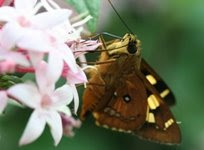Concerns have been raised over the population drop in Australia's largest butterfly, the Cairns Birdwing. Researchers believe that Global Warming will further inpact on this magnifent butterfly, perhaps to point of extinction. Butterfly breeding season is just starting, and wildlife gardens will attract butterflies, especially if host vines are planted. Unlike birdwatching, the best time to observe butterflies is on warm afternoons. For more info on native gardens and planting native plants to attract butterflies and other wildlife,
go to http://www.australian-backyard-wildlife.com
Wednesday, November 25, 2009
Monday, November 16, 2009
Butterflies 12/11/09
Butterflies
The damaged forest in the hills of the Cycloop Mountain in Papua is threatening the habitat of its native butterflies. Thirty years ago, said Brother Henk van Mastringt, Jayapura residents could see about 30 kinds of butterflies. “Now, there are no more than 10,” said Papuan butterfly researcher during the International Biological Diversity Conference in Jayapura yesterday. According to Brother Henk, people who want to see butterflies must go about three kilometers inside the forest before they can see them. Yet, some years ago, these animals could be seen flying around Jayapura Regional General Hospital. He hoped that the government would be more careful when constructing in areas like Foja, Arfak, Wondama and Cycloop, which is rich eco-biodiversity.
Brother Henk said that there were other exotic and protected animals besides the butterflies. In Arfak, Manokwari, for instance, there are 30 species of butterflies. During the period between 2000 and 2004 in Wamena, some areas were deforested, causing butterflies to become extinct. Former Environment Minister Emil Salim said more than 50 percent of Indonesia’s biological diversity is found in Papua. “They are found with a high average of endemic species,” he said, in his address at the International Biological Diversity Conference. Papua also has a complete ecosystem, from coral reefs and mangrove, to savanna, lowlands and highlands, as well as mountains. *Network Item
The damaged forest in the hills of the Cycloop Mountain in Papua is threatening the habitat of its native butterflies. Thirty years ago, said Brother Henk van Mastringt, Jayapura residents could see about 30 kinds of butterflies. “Now, there are no more than 10,” said Papuan butterfly researcher during the International Biological Diversity Conference in Jayapura yesterday. According to Brother Henk, people who want to see butterflies must go about three kilometers inside the forest before they can see them. Yet, some years ago, these animals could be seen flying around Jayapura Regional General Hospital. He hoped that the government would be more careful when constructing in areas like Foja, Arfak, Wondama and Cycloop, which is rich eco-biodiversity.
Brother Henk said that there were other exotic and protected animals besides the butterflies. In Arfak, Manokwari, for instance, there are 30 species of butterflies. During the period between 2000 and 2004 in Wamena, some areas were deforested, causing butterflies to become extinct. Former Environment Minister Emil Salim said more than 50 percent of Indonesia’s biological diversity is found in Papua. “They are found with a high average of endemic species,” he said, in his address at the International Biological Diversity Conference. Papua also has a complete ecosystem, from coral reefs and mangrove, to savanna, lowlands and highlands, as well as mountains. *Network Item
Subscribe to:
Posts (Atom)

